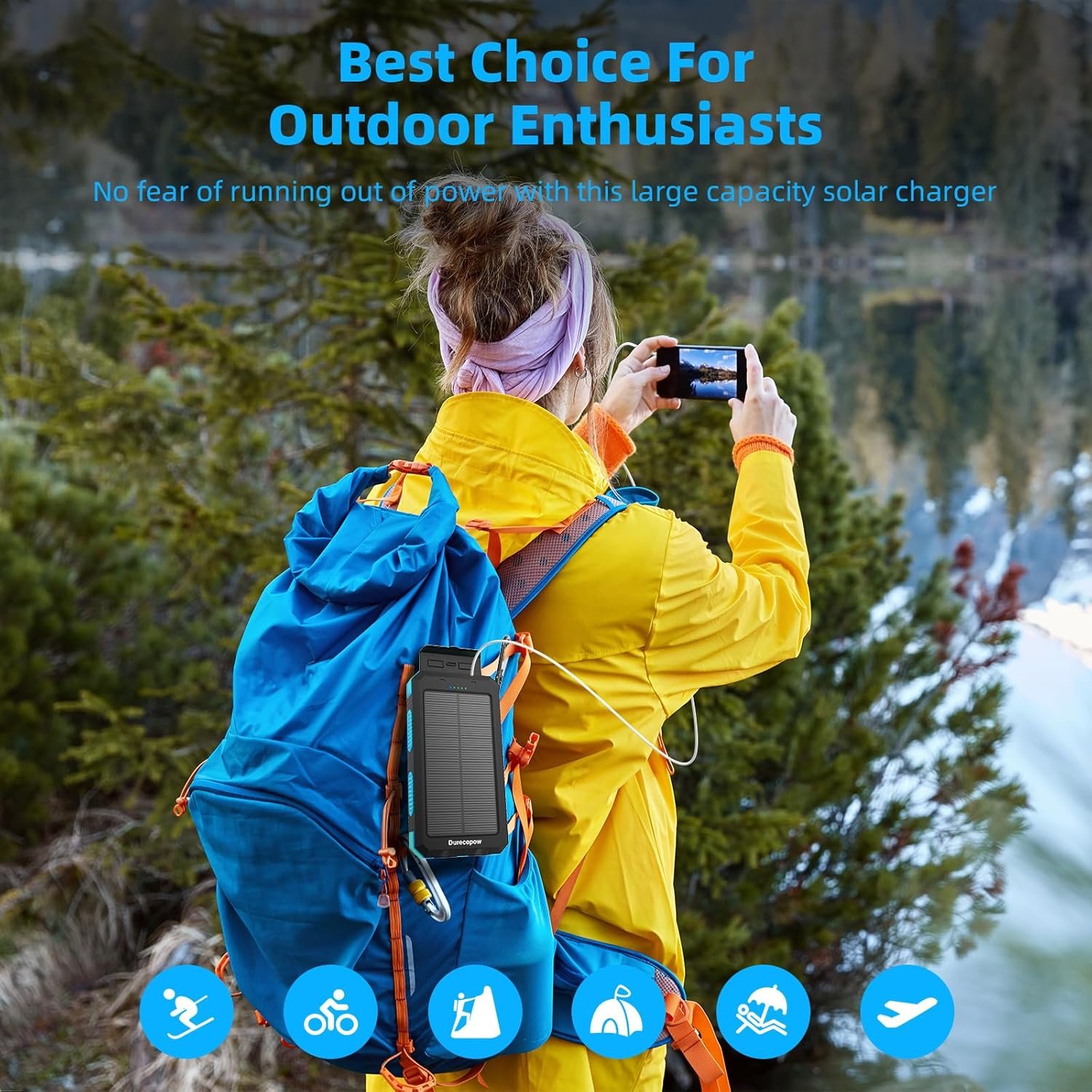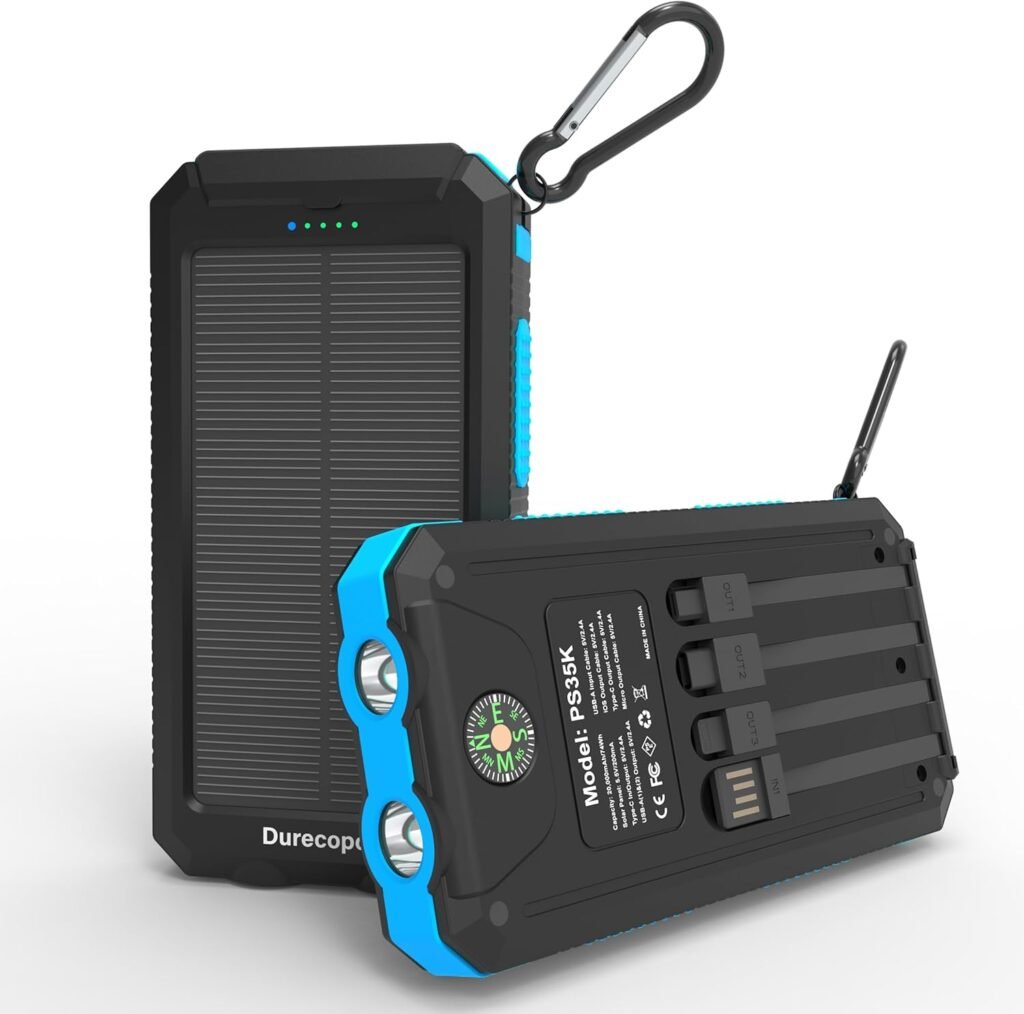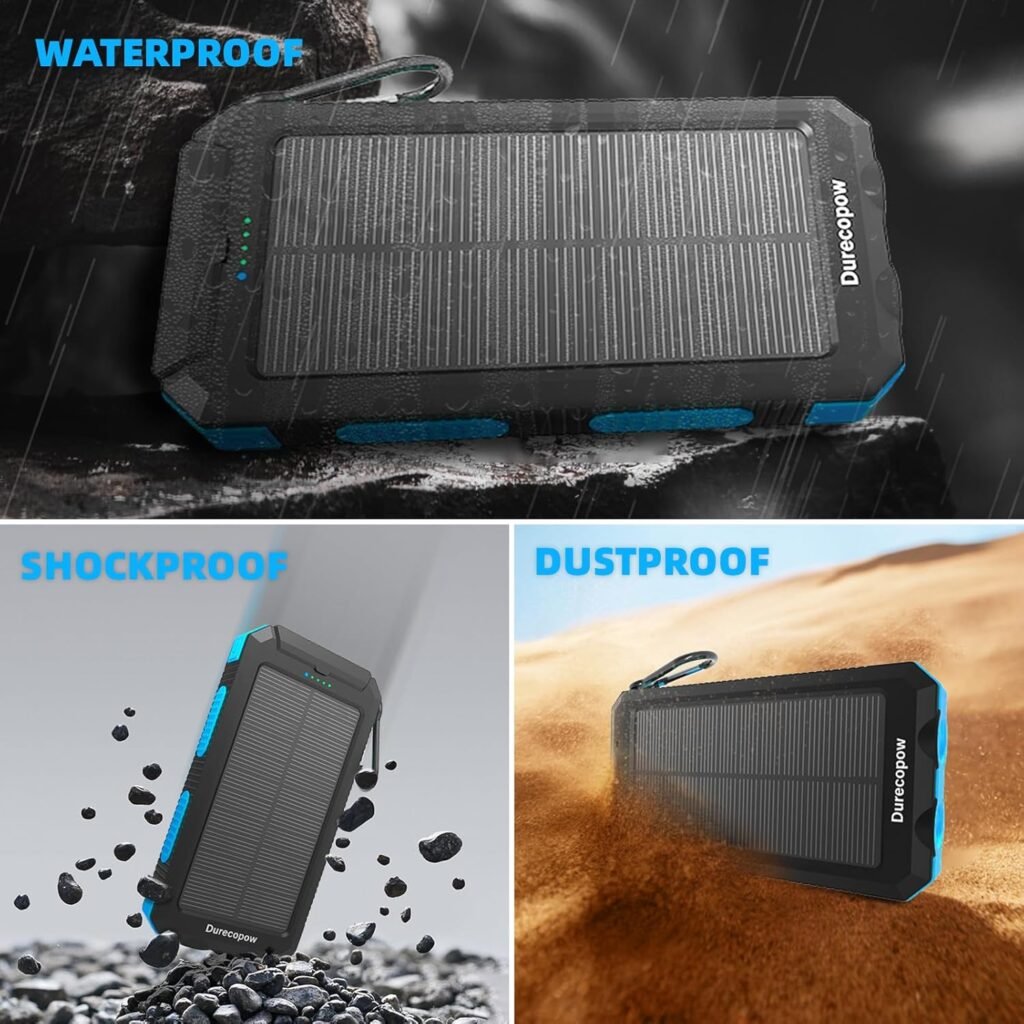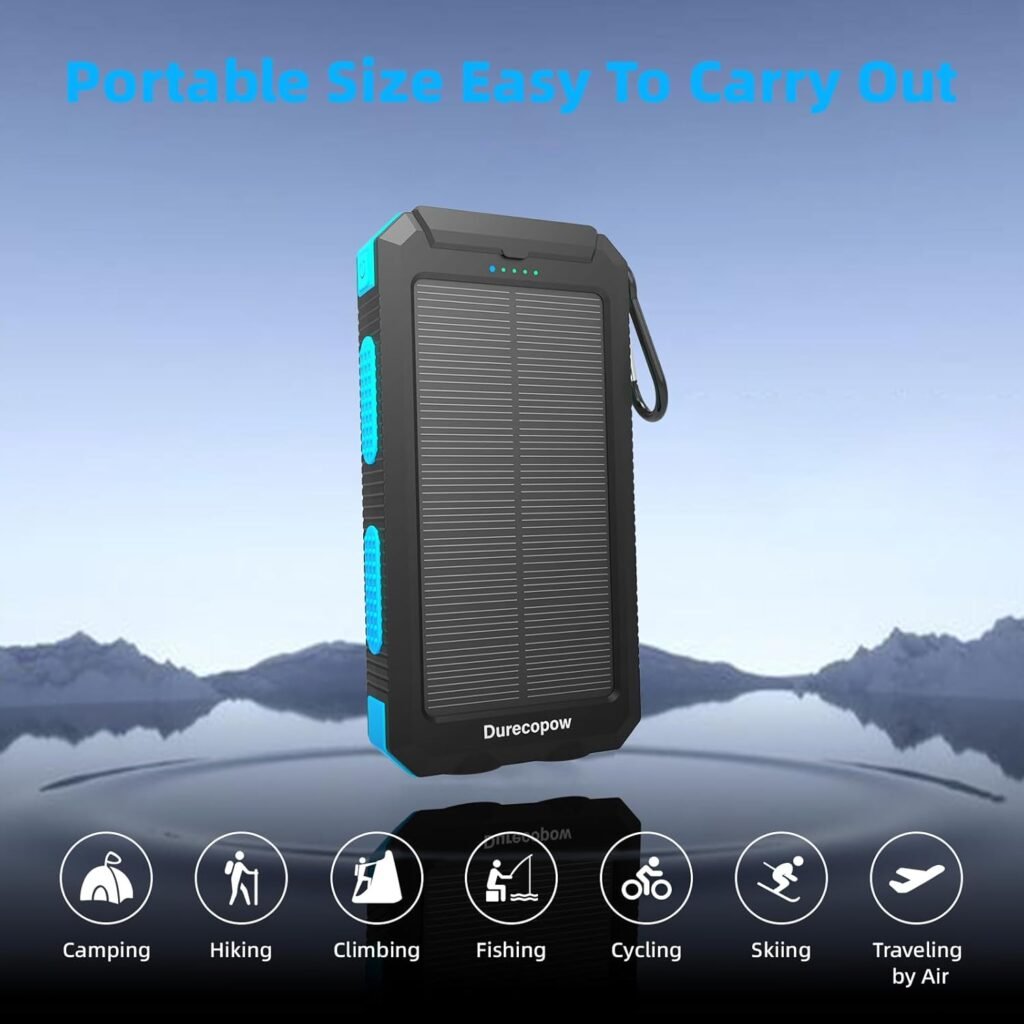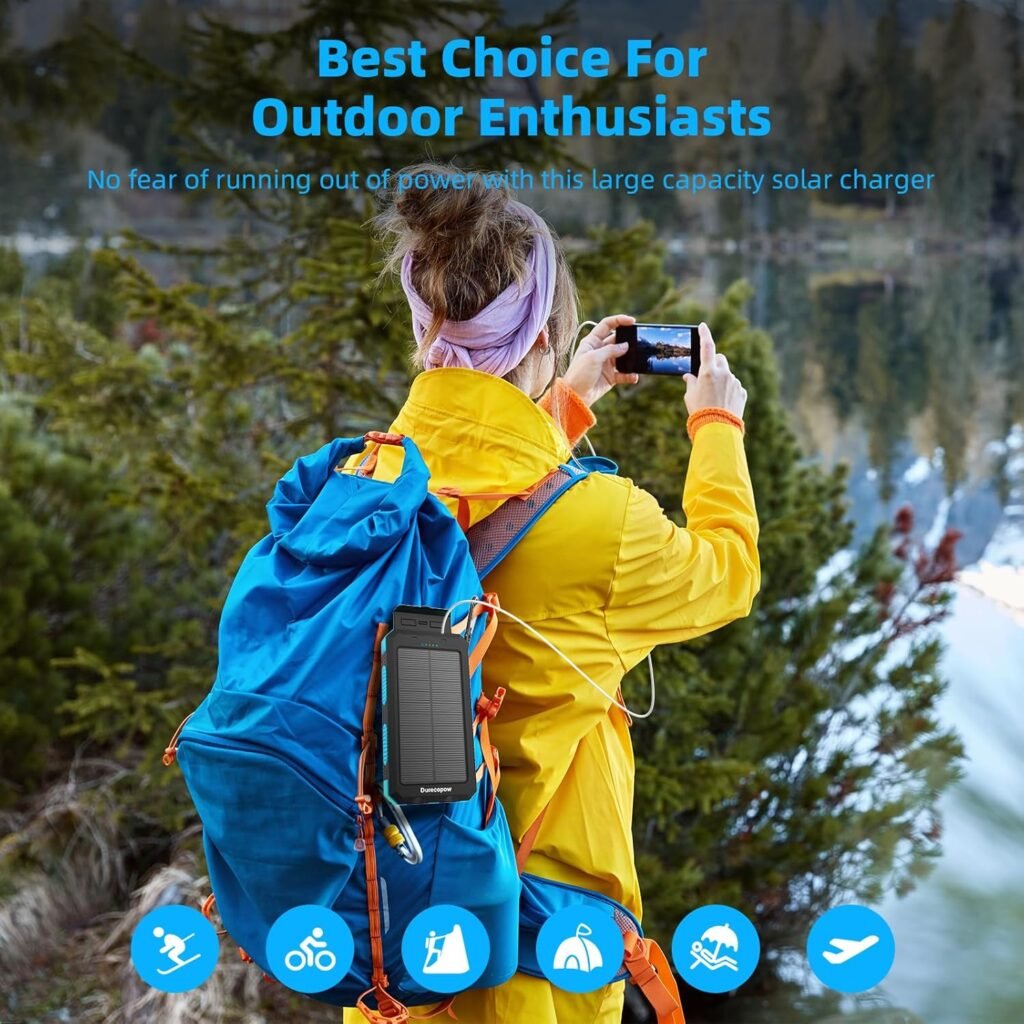Portable Solar Power Bank 20000mAh review
Looking for a rugged, high-capacity power bank that can keep your devices running when you’re away from outlets?
Overview of the Solar Charger Power Bank 20,000mAh, Portable Charger, 4 Cables 3 Ports Fast Charging External Battery Pack with USB C for Cell Phones, Solar Panel Charger with Dual Flashlight for Camping
You want a power solution that’s ready for outdoor use and emergencies, and this Solar Charger Power Bank 20,000mAh promises exactly that. It combines a large battery, an integrated solar panel for emergency recharging, multiple built-in cables and ports, and a rugged design that’s meant to handle camping, hiking, and travel.
You’ll find practical extras like a carabiner, compass, and dual LED flashlight, so this unit is designed with outdoor convenience in mind. The manufacturer positions it as water-resistant, shock-resistant, and dustproof, plus they back it with certifications and a 12-month warranty for added peace of mind.
Key Features
This section breaks down the most important attributes you’ll care about when choosing a portable power bank. Each feature is meant to help you understand how the unit behaves in real-world use.
20,000mAh Battery Capacity
The 20,000mAh capacity is substantial and will give you multiple full charges for most smartphones. That amount of stored energy is especially useful when you don’t have access to mains power for several days.
You should expect to get several full charges for phones and at least a partial charge for larger devices like tablets, depending on each device’s battery size and efficiency. The pack claims more than 1,000 recharge cycles, which suggests reasonable long-term value if you maintain it properly.
Solar Charging Capability
There’s a built-in solar panel to top up the battery when you’re away from power sources. That solar option is most valuable as an emergency, slow trickle charger rather than your main charging method.
You’ll want to treat the solar panel as a backup—good for adding a bit of charge during sunny days, but not fast enough to fully recharge the 20,000mAh pack in a practical window. Positioning the panel correctly in direct sunlight helps, but plan to charge the battery from an outlet before long trips.
Ports and Built-in Cables (4 Cables & 3 Ports)
This power bank includes three built-in output cables (Type-C, Lightning, and Micro USB) plus one USB-A input cable so you don’t need to carry separate cords. It also offers multiple ports: a Type-C input/output and two USB-A outputs.
You can power up to six devices simultaneously by using the built-in cables and the extra ports, which is ideal if you travel with family or a group. Built-in cables reduce clutter, but remember that if one cable gets damaged you can’t replace it as easily as a detachable cable.
Fast Charging and Type-C In/Output
The Type-C port functions as both input and output, which simplifies how you charge the bank and your devices. Fast charging performance will depend on the device you connect and the cable, but the presence of Type-C helps support modern fast-charge protocols.
You should still check the power requirements of your devices: a single high-draw device may use most of the bank’s output capacity, so spreading charge among multiple devices will lower speed for each.
Dual Flashlight with Modes and Indicators
Two LED lights provide flashlight functionality with Steady, SOS, and Strobe modes—useful for nighttime navigation, signaling, or just lighting your tent. Five pilot indicators on the unit give you a quick visual readout of the remaining charge and charging status.
A green light indicates solar charging while a blue light indicates USB charging, making it easier for you to know how the bank is receiving power. The flashlight modes are practical for outdoor use and emergency signaling.
Rugged Design: Water-, Shock-, and Dust-Resistant
You’ll appreciate the ABS PC body with thick silicone on each corner and a protective silicone cover for the ports. The materials and design emphasize drop resistance and protection in harsh outdoor environments.
Although it’s described as water-resistant rather than fully waterproof, that distinction means you can use it in light rain and dusty conditions without immediate failure. You’ll still want to avoid full immersion and prolonged exposure to heavy rain.
Safety Certifications and Materials
The product lists CE, FCC, and RoHS certifications and is made from eco-friendly silicone rubber and ABS PC material. Those certifications indicate compliance with certain safety and environmental standards.
You should still follow normal safety precautions—avoid extreme temperatures, keep the ports covered when not in use, and use the proper cables and adapters for charging.
Warranty and After-Sales Support
A 12-month warranty is included, along with 24-hour online after-sales service and a friendly replacement/refund policy. The manufacturer (MeliTech Store) encourages contacting them directly for support.
You can rely on this warranty if manufacturing issues arise within the coverage period, which adds reassurance when you’re making an outdoor-gear purchase.
Technical Specifications Table
Here’s a concise breakdown of the main specs to help you compare this unit quickly with other options. The table summarizes what you need to know at a glance.
| Feature | Specification | Notes |
|---|---|---|
| Battery Capacity | 20,000mAh | Large capacity for multiple charges |
| Solar Panel | Built-in | Emergency solar trickle charging only |
| Built-in Cables | Type-C, Lightning, Micro USB + USB-A input cable | Reduces need for extra cables |
| Ports | Type-C In/Out, USB-A Output x2 | Charge up to 6 devices simultaneously |
| Flashlight | Dual LED with Steady/SOS/Strobe | Useful for camping and emergencies |
| Indicators | 5 pilot lights | Green = solar charging, Blue = USB charging |
| Materials | ABS PC + Silicone rubber | Drop-resistant corners, port cover |
| Certifications | CE, FCC, RoHS | Compliance with common safety standards |
| Recharge Cycles | 1000+ | Expected lifecycle of battery |
| Ruggedness | Water-resistant, dustproof, shock-resistant | Not fully waterproof—avoid immersion |
| Warranty | 12 months + 24h support | Replacement or refund policy available |
You’ll find this table useful when comparing this power bank against other models if you’re considering performance, durability, or accessories.
Hands-on Charging Performance
When you plug your devices into this power bank, you’ll notice reliable, consistent charging—especially through the Type-C port for compatible phones and devices. The built-in cables are convenient and prevent the hassle of carrying separate cords for common devices.
You should anticipate that charging speed depends on the output limits and the number of devices connected. If you charge multiple devices at once, each device’s charging rate will be shared across the outputs, which can slow down individual charge times.
Solar Charging Reality Check
Solar charging is marketed as a convenient backup, but you’ll find it’s best used for emergency top-ups rather than as a primary charging method. Expect slow replenishment unless you have long, uninterrupted sunlight and optimal panel orientation.
You should plan on charging the power bank via an AC outlet before heading into the backcountry, then using the solar panel to maintain some level of charge if your trip is extended or if you drain the bank unexpectedly.
Charging Multiple Devices Simultaneously
One of the standout claims is the ability to charge six devices at the same time, thanks to the built-in cables and dual USB outputs. This is handy when you’re with family or friends, or when you carry multiple gadgets like a phone, camera, smartwatch, and earbuds.
You’ll want to prioritize which device needs the fastest charge, since total power output is finite. For high-demand devices such as tablets, connect them alone or with only low-power devices to get decent charge rates.
Portability and Build Quality
This bank is designed to be taken outdoors—the carabiner lets you attach it to a backpack for easy carrying, and the compass is a small but thoughtful addition for hikers. The unit is built with thick silicone on corners to absorb shocks and protect it from drops.
You’ll notice the silicone port covers help prevent dirt and water from entering the sockets, but you should still avoid submerging the unit. Overall, the form factor and rugged construction make it a practical travel companion.
Ergonomics and Everyday Carry
The built-in cables mean you don’t have to bring extra cords, reducing clutter in your pack or bag. The trade-off is that if a cable frays or becomes damaged, repairing or replacing it is less straightforward than with detachable cables.
You should treat the built-in cables gently—wrap them carefully, avoid forcing them into tight pockets, and protect the connector ends with the port cover when not in use.
Built-in Cables — Benefits and Drawbacks
Built-in cables offer tremendous convenience because you can leave your charging kit assembled and ready. You’ll never forget a Lightning or Type-C cable again if it’s already integrated into the power bank.
However, built-in cables can be a liability if one breaks. You’ll want to keep the cables protected from sharp bends and heavy pulling, and consider carrying a backup cable or adapter for longer trips if you’re relying heavily on them.
Cable Compatibility and Convenience
The combination of Type-C, Lightning, and Micro USB covers almost every mainstream device, so you can share the bank with people using iPhones and Android devices without a fuss. The extra USB-A output also allows you to connect other peripherals or rechargeable accessories.
You should check that the cable lengths and connector fits meet your needs—built-in cables are often shorter than separate cables, so plan for the typical distances you’ll be working with in camp or at a worksite.
LED Flashlight and Emergency Use
The dual LED flashlights provide multiple modes including Steady, SOS, and Strobe, which are useful in different situations. SOS mode is especially handy if you need to signal for help during an emergency.
You’ll appreciate the added convenience of the flashlight during campsite setup, late-night bathroom runs, or when you need a quick light source without draining your phone battery.
Indicators and Status Lights
Five pilot indicators clearly show battery levels and charging state, with distinct colors for solar and USB charging. This helps you quickly assess whether the bank is receiving solar input or being charged from an outlet.
You should pay attention to the indicator lights before you head out, since they’ll tell you how much usable capacity you have left and whether the unit is actively charging.
Safety, Certifications, and Materials
The unit’s CE, FCC, and RoHS certifications indicate adherence to many standard safety and environmental requirements. Materials used—ABS PC plastic plus eco-friendly silicone rubber—provide a mix of toughness and grip.
You should still avoid subjecting the bank to extreme temperatures and mechanical abuse beyond normal use. The manufacturer’s certifications are a good sign, but common-sense precautions will help extend the life of the pack.
Environmental Protection and Durability
Water-resistant and dustproof features help shield the device from common outdoor hazards, and shock resistance adds confidence when the pack is tossed into a bag. The covered ports further reduce the risk of debris ingress.
You should note that “water-resistant” doesn’t necessarily mean “waterproof,” so avoid soaking the unit or exposing it to heavy rain for prolonged periods.
Battery Longevity and Care
With a stated lifecycle of over 1,000 recharges, this battery is designed to last if you maintain it properly. How you charge and store the pack affects long-term capacity retention.
You should store the battery in a cool, dry place and avoid leaving it fully discharged for long periods. Periodically cycle it and avoid extreme heat to maintain health and performance.
Best Practices for Storage and Use
Charge the pack to around 50–80% if you plan to store it for an extended period. Keep the ports covered, and avoid leaving it in a hot car or direct sun for long stretches beyond normal operation.
You should also avoid using the solar panel as your primary charging source; relying on wired charging will help preserve overall battery capacity and speed up recharge times.
Pros and Cons
This balanced list highlights what you’ll likely appreciate and what might cause you to hesitate before buying.
Pros
- Large 20,000mAh capacity gives you multiple device charges. You’ll feel confident taking it on extended trips where outlets are scarce.
- Built-in cables and multiple ports minimize the need for extra cords. That’s a real convenience for group travel or minimalists.
- Rugged design with silicone protection, port covers, and carabiner suits outdoor use. The unit is clearly aimed at campers and hikers who need durability.
- Dual LED flashlight with SOS and strobe modes adds emergency utility. You’ll have a reliable light source without burning phone battery.
- Certifications (CE, FCC, RoHS) and a 12-month warranty provide peace of mind. Support from the seller can resolve defects within the warranty period.
Cons
- Solar charging is slow and best for emergencies; don’t expect a full recharge from sunlight alone. You’ll still need AC charging for practical replenishment.
- Built-in cables are convenient but less replaceable. If a built-in cable fails, you may need to rely on the USB-A port and carry spare cables.
- Water-resistant rather than fully waterproof—avoid direct immersion or heavy rain for long durations. The unit is protected, but not invincible.
- Exact charging amperage and power delivery specs aren’t detailed, so advanced users may want clearer power ratings for fast charging expectations. You may need to test real-world speeds with your device.
Who Should Buy This Product?
If you often spend time outdoors—camping, hiking, fishing, or traveling off the grid—you’ll benefit from the robust design and large battery capacity. The built-in cables, flashlight modes, and carabiner make this unit especially useful for group travel or family outings.
You should consider this power bank if you value a multi-device solution and predictable durability over the fastest possible solar recharge. It’s also a practical choice if you want a compact kit that reduces cable clutter.
Who Might Prefer a Different Option
If you primarily need extremely fast recharging for high-power laptops or you plan to rely largely on solar recharging, you might prefer a different solution with higher solar efficiency or more detailed power delivery specs. Also, if you want fully waterproof protection for kayak or marine use, look for products specifically rated for immersion.
You should weigh how much you’ll depend on the solar panel and whether built-in cables meet your long-term flexibility needs.
Practical Tips for Using the Solar Charger Power Bank
These tips will help you get the most reliable performance and extend the lifespan of your power bank.
- Charge fully by AC before heading out: Solar is a backup, not your main recharge method. You’ll begin trips with full capacity and avoid dependence on slow solar trickle charging.
- Use the Type-C port for the fastest input/output when possible: This reduces charge times for modern phones and devices.
- Keep ports closed with the silicone cover when not in use: That protects against dust and moisture ingress during outdoor activities.
- Attach via the carabiner during the day to allow the solar panel to receive sun: Hanging it on a backpack or tent can help gather solar input for slow top-ups.
- Rotate device charging priorities: If you charge multiple devices, prioritize the one you absolutely need most to conserve power.
- Avoid extreme temperatures: Do not leave the unit in a hot car or out in very cold conditions for prolonged periods.
- Carry a spare cable if you rely heavily on the built-in connectors: Built-in cables are convenient but not as easily replaced.
You’ll get the most consistent results when you combine smart charging habits with routine maintenance and sensible expectations of solar performance.
Troubleshooting and Support
If your power bank isn’t working as expected, try these first steps to diagnose and fix common issues. Most problems are simple to resolve without returning the unit.
- Check the indicator lights: Confirm whether the unit is charging (green for solar, blue for USB) and whether the battery level shows enough charge.
- Ensure the port cover is fully open and the cable is seated properly: A loose connection can interrupt charging.
- Use an AC outlet to fully charge the unit before testing: This rules out weak solar input as the source of the problem.
- Try different cables and devices: Isolate whether the issue is the bank or the device/cable.
- Reset by disconnecting all devices and letting the power bank rest: Sometimes a brief rest clears minor glitches.
If these steps don’t solve the problem, contact the seller (MeliTech Store) for warranty or replacement: they offer a 12-month warranty and 24-hour online after-sales support. Keep your order details handy when you reach out for faster assistance.
Comparisons with Similar Products
Compared with smaller capacity power banks, the 20,000mAh pack gives you longer runtime and more device charges. Compared with larger, heavier solar generators, this unit is significantly more portable but offers less raw recharging power and shorter solar panel surface area.
You should match the choice to your needs: this unit is a strong all-around pick for hikers and campers who want a balance of capacity, portability, and ruggedness, while true off-grid users might opt for larger solar kits.
How It Stacks Up for Everyday Use
For daily commuters or people who primarily charge at home, this bank might be overkill in size and capacity. However, you’ll still appreciate the convenience of built-in cables and the security of having a large reserve battery when needed.
You should consider the trade-offs: if you rarely leave the city, a smaller, faster bank might be more pocket-friendly; if you spend weekends off-grid, this one shines.
Real-World Scenarios and Use Cases
Thinking through scenarios helps you picture how the unit performs in the field. You’ll know what to expect when your phone runs low during hikes or your GPS needs a quick boost.
- Weekend camping trips: Charge phones, headlamps, and camera batteries for several days without mains power. Use the flashlight modes for campsite tasks.
- Emergency kit at home: Keep the unit ready for power outages, with the flashlight and SOS mode available for signaling.
- Group travel: Share the bank among friends or family using the built-in cables and extra USB ports.
- Road trips: Leave the bank in the car for quick top-ups and in-case-of-breakdown signaling with the SOS light.
You should plan device charging order and keep essentials like your phone and emergency radio prioritized for the best outcomes.
Final Verdict
If you want a durable, high-capacity portable charger with built-in cables, emergency lighting, and a solar backup, this Solar Charger Power Bank 20,000mAh is a solid pick. It blends thoughtful outdoor features—carabiner, compass, waterproof port cover—with the practical convenience of multiple cables and ports.
You’ll get reliable performance for camping, travel, and emergency preparedness, provided you use the solar panel as an occasional top-up rather than your main charging method. With certifications, a 12-month warranty, and 24-hour support, this power bank offers good value for outdoor enthusiasts who prioritize durability and multi-device capability.
If you want help comparing this model to a specific competitor or need advice picking the best pack for a particular trip, tell me your typical devices and trip length and I’ll tailor recommendations to your needs.
Disclosure: As an Amazon Associate, I earn from qualifying purchases.
